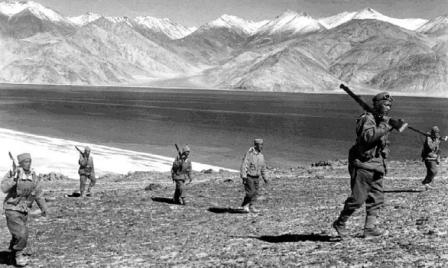 The Sino-Indian War occurred in 1962. A disputed Himalayan border was the main pretext for war, but other issues played a role. There had been a series of violent border incidents after the 1959 Tibetan uprising, when we granted asylum to the Dalai Lama. Unable to reach political accommodation on disputed territory along the 3,225-kilometer-long Himalayan border, the Chinese launched simultaneous offensives in Ladakh and across the McMahon Line on 20 October 1962.
The Sino-Indian War occurred in 1962. A disputed Himalayan border was the main pretext for war, but other issues played a role. There had been a series of violent border incidents after the 1959 Tibetan uprising, when we granted asylum to the Dalai Lama. Unable to reach political accommodation on disputed territory along the 3,225-kilometer-long Himalayan border, the Chinese launched simultaneous offensives in Ladakh and across the McMahon Line on 20 October 1962.
The cause of the war was a dispute over the sovereignty of the widely-separated Aksai Chin and Arunachal Pradesh border regions. Aksai Chin, historically belonged to Kashmir. China claimed it to be part of Xinjiang, and started building a road link that connected the Chinese regions of Tibet and Xinjiang. China's construction of this road was one of the triggers of the conflict. Arunachal Pradesh, called South Tibet by Chinese, was also claimed by Chinese as a part of their land.
 Chinese troops advanced over our forces in both theatres, capturing Rezang la in Chushul in the western theatre, as well as Tawang in the eastern theatre. The war ended when the Chinese declared a ceasefire on 20 November 1962, under immense International pressures, and simultaneously announced its withdrawal from the disputed areas.
Chinese troops advanced over our forces in both theatres, capturing Rezang la in Chushul in the western theatre, as well as Tawang in the eastern theatre. The war ended when the Chinese declared a ceasefire on 20 November 1962, under immense International pressures, and simultaneously announced its withdrawal from the disputed areas.
The Sino-Indian War is notable for the harsh conditions under which the fighting took place, entailling large-scale combat at altitudes of over 4,250 metres (14,000 feet). This presented enormous problems. The Sino-Indian War was also noted for the non-deployment of the navy or air force by either side.
The war displayed the unpreparedness of our army and led to numerous changes in our foreign relations. This war also played a major role in defining the course of the cold war.
